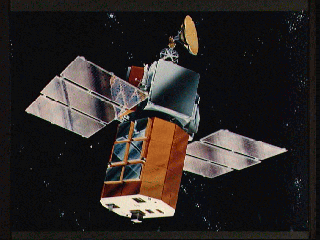|
|
Solar Maximum Mission (SMM)

The Solar Maximum Mission (SMM) was launched on 14 February 1980 to,
primarily, study the Sun during the high part of the solar cycle. The
payload included the Active Cavity Radiometer Irradiance Monitor
(ACRIM), the Gamma-Ray Spectrometer (GRS), the Hard X-Ray Burst
Spectrometer (HXRBS), the soft X-Ray Polychromator (XRP), the Hard X-ray
Imaging Spectrometer (HXIS), and the Ultraviolet Spectrometer and
Polarimeter (UVSP). The GRS and HXRBS however, could also observe
celestial sources. A malfunction in the satellite in January 1981 cut
short the original mission. SMM was recovered by the space shuttle
Challenger in April 1984 and serviced in orbit. It then served out its
productive life until burning up in the Earth's atmosphere on 2 December
1989.
HXRBS
The primary objective of HXRBS was to study hard X-ray spectra of solar
flares on time scales as short as 10 ms. The Principal Investigator
was K. Frost. The HXRBS instrument could also be used for
observing the hard X-ray spectra of gamma-ray bursts which fell within the
field of view of the detector. The HXRBS detector consisted of a CsI (Na)
scintillator with a radius of 4.67 cm and thickness of 0.64 cm. The crystal
was surrounded on all sides (except for the solar direction) by a CsI (Na)
shield of thickness 3.2 cm. Events were pulse height analyzed in 15 channel
energy spectra from 30-500 keV. The time resolution was 128 ms. However, the
total count rate over the same energy ranges was
recorded every 10 ms. The HXRBS threshold for detecting a gamma-ray burst
was 1e-7 ergs/sq-cm (E > 30 keV). Since the SMM views the Earth during the
nighttime portion of each orbit, only about 1 event on 40 is detected with
a pi/6 sr field of view for which the spectra are not badly contaminated by
the shield-processed contributions. Between launch and mid-1985, more than
15 gamma-ray bursts were seen by the HXRBS.
GRS
The GRS was designed for investigation of the gamma-ray spectrum of solar
flares. The Principal Investigator was E. Chupp. The main detector was
an array of 7 gain-controlled 7.6 cm diameter x 7.6 cm thick NaI(Tl)
detectors. A complete spectrum was obtained every
16.38 s in the energy range 0.3 - 9.0 MeV. The number of counts in the 4.2-6.4
MeV range was read out every 2.048 s. The number of counts in a 50 keV
wide window around 300 keV was read out every 64 ms. The spectrometer was
shielded by a 2.5 cm thick annulus of CsI(Na) and a 25 cm diameter x 7.6 cm
thick back detector. The shield elements defined a field of view of 135
degrees (FWHM) in the solar direction. The CsI back detector and the 7 NaI
detectors together provided an effective area of ~ 100 sq-cm and 4 energy
channels from 10-100 MeV. The number of counts in these energy channels
was read out every 2.048 s. The experiment was complimented by a pair of
8 sq-cm x 0.6 cm thick NaI(Tl) detectors which measured the X-ray portion of
the spectrum every 1.024 s in the energy range 13-182 keV. The GRS detection
threshold for gamma-ray bursts in the field of view was ~ 5e-6 ergs/sq-cm
(E > 300 keV). Between launch and mid-1985, GRS detected at least 75 bursts.
[Gallery]
[Publications]
[NSSDC SMM Archive]
[HEASARC SMM Catalog]
[NASCOM SMM Catalog]
[All Missions]
[by Time]
[by Energy]
Page authors: Lorella Angelini Jesse Allen
HEASARC Home |
Observatories |
Archive |
Calibration |
Software |
Tools |
Students/Teachers/Public
Last modified: Monday, 10-May-2010 10:13:59 EDT
|


